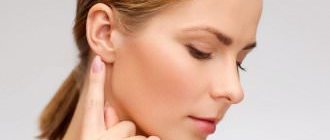We live in a constant abyss of worries: heaps at work, bills for housing and communal services, an atrocious boss and early rises. All this fuss affects the human nervous system and causes headaches. However, not only a busy schedule can cause its appearance; there are many other explanations for this illness.
It is very rare to meet a person who has not experienced a headache. This complaint is one of the most common, according to doctors. And more than 13% of the population of our planet suffers from chronic headaches.
What if your head hurts in your temples?
Temporal headache is the most common type of headache.
Experts attribute the following to the primary reasons:
- neuralgia
- cluster pain
- overvoltage
- migraine
Secondary causes include:
- cerebral vascular damage
- taking medications
- head or neck injury
- non-vascular intracranial lesions
- HIV infection and AIDS
- hemostasis disorder
- pathology of the skull
- psychological illnesses
What to do if you have a headache in your temples? – If this happens for the first time, then you need to take an analgesic. If the pain persists after taking painkillers, you should consult a specialist. If you experience intense and frequently recurring pain in your temples, it is better to consult a therapist or neurologist. If the pain is a consequence of an injury, then you should make an appointment with a surgeon or traumatologist.
Diagnostics
If you regularly experience discomfort in your temples and dizziness, you should definitely consult a doctor. If there are signs of vascular diseases, you should make an appointment with a cardiologist; in other cases, a consultation with a neurologist is indicated. If it is not possible to measure blood pressure or the nature of the symptoms does not allow you to independently figure out which specialist’s help is needed, it is better to initially consult a therapist. A general practitioner will help determine the cause of the problem and, if necessary, refer the patient to a specialist.
Initially, a survey of the patient is carried out, during which the characteristics of pain in the temples, the circumstances of its occurrence, the type of dizziness and the nature of other symptoms present are established. The doctor must examine the patient, measure blood pressure and, if necessary, perform neurological tests, which helps narrow the list of possible causes of poor health.
For accurate diagnosis of pathology and assessment of the severity of changes, the following may be prescribed:
- X-ray of the cervical spine;
- CT scan of the brain and skull;
- MRI of the brain and cervical spine;
- CT angiography;
- Ultrasound scanning of the vessels of the neck and head;
- 24-hour blood pressure monitoring;
- electroencephalography (EEG);
- UAC, OAM.
What if you have a headache in the back of your head?
Usually such a severe headache chills a person and prevents him from functioning normally. This is a very serious inflammation that you should not experience on your own without medical help. Usually the back of the head hurts due to pathologies. It is better not to try to relieve the disease with analgesics, but to immediately consult a doctor.
Headache in the back of the head can be a signal of diseases:
- nervous system
- vessels
- spine.
Causes of headaches in the back of the head:
- Tension headache. Usually discomfort is associated with tension in the neck muscles. They compress the arteries and nerves that carry blood and impulses to the brain, which is accompanied by a pain reaction in the back of the neck and in the back of the head. In some cases, the provoking factor is emotional tension and stress, which leads to spasm of the neck muscles.
- Migraine is an acute and painful attack of unilateral and occipital headache. An attack can last for several hours or several days. The cause of the disease can be physical activity, overexertion and changes in weather conditions. Most often, women suffer from migraines, and the average age of those affected is from 25 to 35 years.
- Osteochondrosis of the cervical spine is a chronic progressive disease that thins the cartilage in the neck. It can occur after a neck injury, vertebral displacement, sedentary lifestyle or excess weight. The disease can also cause pain in the back of the head.
- Sudden pressure surges.
- Occipital neuralgia provokes an acute headache. Discomfort begins in the occipital region, but can spread to the frontal and temporal lobes. This condition can occur after a neck injury, arthritis, or muscle spasms.
- Use of medications. In self-medication, people “prescribe” themselves medications to treat migraines. This initiative provokes a medicinal headache. It occurs as a reaction of the body to frequent intake of active substances of analgesics.
Pain in the temple area
Arthritis
16178 October 28
IMPORTANT!
The information in this section cannot be used for self-diagnosis and self-treatment.
In case of pain or other exacerbation of the disease, diagnostic tests should be prescribed only by the attending physician. To make a diagnosis and properly prescribe treatment, you should contact your doctor. Pain in the temple area: causes of occurrence, what diseases it occurs with, diagnosis and treatment methods.
Definition _
Pain in the temple area is one of the most common complaints that brings patients to the doctor.
In the bone structures of the skull and brain tissues, pain sensitivity is insignificant, so the main sources of pain are blood vessels, meninges and cranial nerves.
Types of pain in the temple area
According to the International Classification of Headaches 3 (2013), all headaches are divided into:
- for primary pain not associated with diseases of the brain and other structures of the head and neck;
- secondary pain associated with other diseases;
- painful cranial neuropathies, other facial and headaches.
Possible causes of pain in the temple area
Arterial hypertension
is one of the common causes of headaches in the back of the head and temples. When pressure increases, attacks of headaches occur, which may be accompanied by nausea, vomiting, and “spots” before the eyes.
Tension headache
– one of the common reasons for visiting a neurologist and therapist. Patients characterize it as squeezing, pressing.
Tension headaches interfere with quality of life and performance, despite the fact that they are considered benign and do not carry serious consequences.
Migraine
is the most common form of attack-like headache.
Migraine is characterized by localization of pain in the temporo-frontal-orbital region and a paroxysmal nature of the course.
If the pain is not paroxysmal, then it is not a migraine. Seizures can occur on one side of the head or on both sides, and can also change their location (right-left).
A headache attack can occur at any time of the day, more often during a night's sleep in the morning or after waking up. The pain is pulsating, bursting, with a gradual increase in intensity over several hours. Before the onset of an attack, a so-called aura is possible (harbingers of pain, they vary from person to person, but are often described as disturbances in vision, speech, or dizziness). The pain intensifies in bright light, from loud sounds and other irritants, including changes in head position. The attack can last up to several days.
Harris' periodic migraine neuralgia
- characterized by the sudden onset of pain in the eye area on one side and spreading to the temporal, frontal and zygomatic areas, and sometimes even to the neck.
Unlike migraines, there are no warning signs of pain.
The pain is burning, cutting, bursting, accompanied by redness of the eye and lacrimation on the painful side. Some patients experience a sensation of the eye “bulging out of its socket.” All these attacks are characterized by a certain seasonality or periodicity. The duration of the attack ranges from 6–8 weeks to 3 months.
Pain in the temple area may occur immediately after drinking cold water
or ice cream due to arterial spasm. In this case, the pain is aching, squeezing, sometimes throbbing.
Cold pain occurs in individuals with increased sensitivity to cold stimuli and high reactivity of the body.
“Sausage” headache
(in English-speaking authors -
hot dogs headache
) occurs when eating foods containing food additives such as sodium nitrate. During a chemical reaction in the body, nitrate is converted into nitrite, which has a vasomotor effect (controlling the process of contraction and relaxation of the muscular lining of the walls of blood vessels, and, consequently, the lumen of blood vessels), and sensitive people may feel pain in the frontotemporal region.
A similar effect sometimes occurs when eating Chinese dishes (“Chinese restaurant headache”), where monosodium glutamate is often used.
Giant cell arteritis
is the most common systemic vasculitis in the world, affecting large vessels. The favorite localization of this disease is the temporal artery. Most often, the pain is intense, accompanied by limited function of the corresponding temporomandibular joint, blurred vision with its gradual decrease, and a hardened artery in the temple area is detected.
Without treatment, it can lead to permanent blindness of the eye on the affected side.
With inflammatory diseases of the ear,
pain in the temporal and parotid region is possible, which is accompanied by fever, redness, swelling in the ear area, and purulent discharge from the ear.
Meningitis
develops when an infectious agent enters the membranes of the brain, followed by an inflammatory process.
The headache is sudden, sharp, diffuse, predominant in the frontotemporal areas, sometimes accompanied by vomiting.
Neuralgia of the auriculotemporal nerve
often occurs after an inflammatory process or traumatic lesion of the parotid gland. It is characterized by burning, throbbing pain in the area of the external auditory canal, temple, temporomandibular joint, radiating to the lower jaw. The pain is accompanied by increased salivation and redness of the skin over the affected area. Attacks are triggered by eating and smoking.
Neuralgia of the ear ganglion
manifests itself as attacks of burning pain in the temporal region lasting from several minutes to an hour. May be accompanied by ear congestion and increased salivation.
For altitude sickness
There is a change in arterial tone due to reduced oxygen pressure and changes in barometric pressure. Headache is accompanied by shortness of breath, palpitations, and blurred vision.
The severity of symptoms depends on the speed of ascent to altitude.
The pain is relieved by applying cold to the temples and drinking cool water.
Traumatic lesion of the temporal region
may be the cause of pain. This includes a wide group of pathologies: fracture of the temporal bone, dislocation of the temporomandibular joint, soft tissue contusion.
Subarachnoid hemorrhage
occurs for various reasons, for example, as a result of a rupture of a cerebral aneurysm, a person feels like a strong blow to the head, hot liquid pouring into the head, strong contraction, and then bursting. The pain may initially be localized in the corresponding part of the head - in the temporal region when an aneurysm of the internal carotid artery ruptures.
Damage to the temporomandibular joint
(both inflammatory - arthritis, and non-inflammatory - arthrosis, malocclusion) may be accompanied by pain in the parotid and temporal region. When moving the lower jaw, crunching and clicking may occur in the joint; the pain intensifies when chewing and during conversation.
Which doctors should I contact if I have pain in my temples?
If you experience intense and recurring pain in your temples, you should consult a specialist.
If pain persists after taking painkillers or other symptomatic treatment previously prescribed by your doctor (for example, to lower blood pressure), and there are no signs of injury, you should contact or. Depending on the accompanying symptoms, you may need to consult a neurologist, rheumatologist, otolaryngologist, or ophthalmologist. In case of previous injury, it is necessary to contact a traumatologist or to exclude severe injury.
Diagnostics and examinations for pain in the temples
The list of examinations is prescribed by the doctor depending on the indications. An approximate list of studies that may be prescribed:
- computed tomography of the head;
Why does my head hurt and feel nauseous?
Among the causes of nausea and headaches are infectious and non-communicable diseases, pathologies of the nervous and cardiovascular systems. The disease manifests itself due to intoxication and insufficient blood supply to the brain. Typically these symptoms indicate severe fatigue and impairment. This type of headache can also occur during pregnancy.
Causes:
- Overwork and lack of sleep. The body does not have time to recover and rest due to lack of sleep, which leads to negative health.
- Viral diseases that affect body systems and organs. Additional symptoms in such cases will be fever, muscle and joint aches.
- Viral diseases can cause headaches and nausea. For example, flu or sore throat, as well as seasonal infection, can trigger the disease. In this case, experts recommend bed rest and drinking plenty of fluids.
- Lyme disease is an infectious disease caused by a tick bite.
- Pregnancy.
Why does my head hurt in the forehead area?
This phenomenon is quite common in all age groups of the population. Such pain can be acute or chronic, occur independently or in combination with other symptoms. Pain in the frontal lobe occurs even in a healthy person, so their one-time occurrence should not be a cause for concern.
If a person constantly has a headache in the frontal lobes, then there are a number of reasons for this:
- Tension headaches can occur even in healthy people. We must remember that rest is an integral part of the life process. This pain may go away after taking analgesics.
- Eye pain may also spread to the forehead area. The pain begins behind the eyes and spreads to the frontal lobe. Its manifestations are similar to tension headaches: they occur against the background of overwork or active mental work, last from several hours to several days, and are easily relieved with over-the-counter analgesics.
- Sinusitis causes sharp pain in the frontal part of the head and nose. Accompanied by impaired nasal breathing, lacrimation and decreased sense of smell.
- Arteritis is considered the rarest cause of headaches. The disease is associated with inflammation of the walls of large arteries. They become dense and visible above the surface of the skin. The main symptom of the disease is acute pain in the forehead.
When relief comes
Sometimes this symptom appears suddenly, more often it increases along with signs of fever. With a mild course of the disease, a severe headache usually continues in the first 1–2 days. After this time, it gradually weakens, the temperature drops slightly and catarrhal symptoms develop: a wet cough and runny nose. Slight dizziness, dazedness and a feeling of heaviness may continue for several days.
In people who are seriously ill with the disease, the pain is protracted, haunts them around the clock, does not respond well to painkillers, and leaves them in their sleep for a short time. From the first hours until complete recovery, patients feel completely overwhelmed, cannot leave their bed for a long time, are unable to work or eat normally. In such cases, the headache may continue to hurt for up to 2-3 weeks.
Why does my head hurt after sleep?
A morning headache brings discomfort throughout the day. Night sleep is the time when, after a hard day, our body restores strength. But from time to time awakening is overshadowed by unpleasant sensations.
The reason for such an uncomfortable awakening may be:
- Uncomfortable sleeping position.
- Incorrectly chosen pillow or mattress. Ignoring this moment leads to morning pain throughout the body, including the head.
- When the condition of blood vessels deteriorates, blood pressure is disturbed, which affects the quality of our sleep. Then feeling unwell becomes frequent.
- Head injuries can also contribute to headaches in the morning. It can occur a week or a month after the injury.
- Sinusitis makes breathing difficult, which causes a headache when waking up.
- Cervical osteochondrosis is a displacement of the spine in the cervical region. With this disease, the supply of oxygen to the brain is disrupted.
Does paracetamol help with headaches?
Paracetamol is an affordable and time-tested medicine for various types of pain. The drug alleviates the physical condition and has almost no side effects. The medicine helps adults and children, but requires careful dosage when used.
Paracetamol mainly acts as a pain reliever. The phenacetin derivative inhibits the production in the body of compounds responsible for sensitivity to pain - prostaglandins. At the same time, it affects the thermoregulation centers, reducing high body temperature.
Paracetamol is good for relieving headaches in acute respiratory infections. In other cases, it is worth using another analgesic or seeking medical help. In some cases, paracetamol will only dull the pain, but not solve the problem completely.










